All published articles of this journal are available on ScienceDirect.
The Impact of High Speed Rail on Tourism Development: A Case Study of Japan
Abstract
In order to clarify the impact of Shinkansen network extension on tourism development in Japan, this study investigates the change of tourism demand and tourist behavior in Tohoku and Kyushu Region by using statistical data collected by MLIT and JTA. The results suggest that tourism arrivals increased significantly in cities that were connected by the extended Shinkansen network. In addition, modal share of railway showed obvious increase as well. This paper also reviews the policies that have been adopted to promote tourism development by utilizing Shinkansen through a case study of Hirosaki and Ibusuki city. In order to clarify the impact of HSR and policy effort on tourism demand, Ordinary Least Square (OLS) regression analysis is conducted in this study. The model estimation result suggests that the shorter distant from HSR station will result in an increase of tourism demand to a certain destination. In addition, it indicates that the simultaneously operation of Shinkansen and scenic trains will significantly increase the tourism demand. However, such influence will decay over time. Specifically speaking, although it has great influence on tourism demand in the first year, such influence becomes insignificant in the second year.
1. INTRODUCTION
On 1 October 1964, the first line of high speed railway (HSR) in Japan -- Tokaido Shinkansen began service between Japan’s two largest cities of Tokyo and Osaka, just in time for the opening of the Tokyo 1964 Olympics. Since then, the Shinkansen has played an important role in Japanese business and leisure travel. The conventional Limited Express service took six hours and 40 minutes from Tokyo to Osaka, but the Shinkansen shortened the trip to three hours and ten minutes by 1965. It enabled day trips between Tokyo and Osaka, the two largest metropolises in Japan, which changed the style of business and life of Japanese people significantly, and increased new traffic demand. The service was an immediate success, reaching the 100 million passenger in less than three years. The Tokaido Line's rapid success prompted an extension westward to Hiroshima and Fukuoka in 1975, and northward to Niigata, Nagano, and Hachinohe in 1982, 1997, and 2002, respectively (Fig. 1). Until then, the Shinkansen network had linked most major cities on the islands of Honshu in Japan.
Based on the government’s Shinkansen construction plan, the Shinkansen network in Japan is under extension again recently. In the “Grand Design of National Spatial Development towards 2050” released by Ministry of Land, Infrastructure, Transport and Tourism (MLIT) in 2014, “compact” and “networks” have been defined as the key in the future spatial development in Japan. The report argued that effective service delivery in a population decreasing society requires geographical compact, which may however lead to a shrinking of regions and markets. It would thus be necessary to achieve agglomeration advantages by networking regions, adapted to the urban functions of the individual areas.
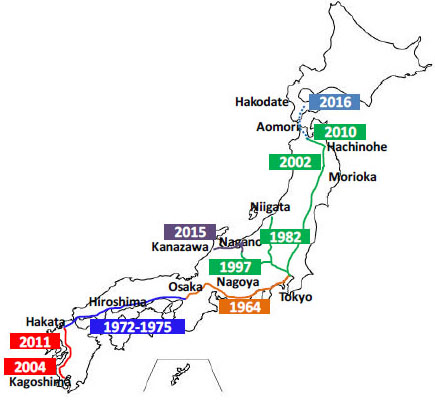
The extension of Shinkansen network in Japan.
The recent extended Shinkansen includes Tohoku Shinkansen, Kyushu Shinkansen and Hokuriku Shinkansen. The Tohoku Shinkansen has been extended to Aomori in the year 2010 and the Kyushu Shinkansen has been extended to connect Fukuoka in the north with Kagoshima in the south and started operation on March 12th 2011. As a result, the travel time between Kyushu and Kansai region of Japan reduced significantly. More specifically, the travel time from Kagoshima to Osaka reduced to 3 hours 42 minutes, compared with 5 hours before the extension of the Shinkansen network. The improvement in accessibility has led to various changes of tourism industry in Kyushu. Furthermore, the Hokuriku Shinkansen has been extended to Kanazawa in March 2015 and the Hokkaido Shinkansen is scheduled to connect Aomori and Hakodate until March 2016. Such extension connects Kanazawa and Hakodate with the Tokyo Metropolitan area, which is the largest origin market of domestic tourism. Therefore, the tourism sectors in these two regions have high expectation that tourism demand will increase accordingly.
Currently the discussion about the impact of Shinkansen extension in Japan focuses on two issues, one is the decrease of population. At the beginning, Shinkansen network was built to connect cities with large population size. Now with Shinkansen network being extended to small size cities, there are discussions concerning the scale of impact [1]. The other issue is the limitation of government financial budget. There is trade-off to be made on whether it is appropriate to make investments on HSR in small size cities [2]. Therefore, it is important to understand the impact of HSR in these cities, among which the impact on tourism development is a key aspect.
Therefore, the objectives of this study are: (1) to investigate the influence of Shinkansen network extension on tourism demand and tourist behavior, such as travel mode choice, stay duration, and expenditure; (2) to review policies that have been adopted to enhance the impact of Shinkansen on tourism development in Kyushu and Tohoku regions; (3) to examine the effect of these policies on tourism development.
2. REVIEW
The transport system plays an important role in tourism development. Recently, with major investments on High Speed Rail (HSR) system being carried out all around the world, the impact of HSR on tourism industry has been the focus of more research. The construction of HSR system results in a reduction in travel time and accessibility improvement, which can serve as a tool for promoting tourism development. The existing studies have proved the positive influence of HSR on tourism industry. For example, Chen and Haynes [3] investigate the impact of China’s HSR system on its tourism industry. Through a multivariate panel analyses, their study confirms that during the period between 1999 and 2010, the emerging HSR system do have significant impacts on boosting tourism development in China. Masson and Petiot [4] discussed the influences of the Southern European high speed rail (HSR) between Perpignan (France) and Barcelona (Spain) on both tourism activity and economic development. They argued that HSR can facilitate the development of tourism activities, in particular business tourism and urban tourism. In addition, the impact of HSR on tourism industry has been extensively discussed through its influence on labor market. For instance, some studies found that HSR will dramatically expand the economic scale of tourism related sectors such as food and accommodations [5, 6].
On the other hand, some researchers argued that the effects of the HSR are spatially differentiated [7]. As stated by Masson and Petiot [4], a decrease in travel time can reinforce the concentration of economic activities, which may result in the phenomenon of the tourism activities agglomeration in one destination to the detriment of others. They further point out that the positive effects of the HSR are not automatic but are related to the development of integrated products, associating multiple public and private partners. Similarly, based on the analysis about the effects of China's HSR network on its regional tourism development, Wang, Huang, Zou, and Yan [8] suggest the emerging HSR system in China will strengthen some Chinese cities as tourism centers and weaken others.
Moreover, the analyses about the effects of HSR system on tourism show significant change in tourist behavior. As suggested by Prideaux [9], if the ability of tourists to travel to preferred destinations is limited by inefficiencies in the transport system, there is some likelihood that they will seek alternative destinations. The introduction of HSR, therefore, can have a significant influence on tourists’ destination choice. Because of the travel time saving and much direct connection due to HSR, an increase of tourist arrivals had been observed after the construction of HSR system in many case studies [10]. However, overnight stays dropped due to same-day travel. Masson and Petiot [4] show that although tourism trips increased considerably in Lyon (France) after the completion of HSR line between Paris and Lyon, tourists’ average length of stay dropped from 2.3 days in 1980 to 1.7 days in 1992.
Suda [11], the first president of Central Japan Railway Company, made a report in 2014 concerning with the impact of Shinkansen on tourism development in Japan. According to the report, the construction of Shinkansen has led to significant increase in tourism demand in almost all the area. However, such influence was proved to be temporary. Most area witnessed decrease in tourism demand several years after the opening of Shinkansen. In addition, he listed Okayama Prefecture as a positive example, which experienced continuous increase in tourism demand since the opening of Sanyo Shinkansen in 1972. He stated that various efforts had been made in Okayama Prefecture to promote tourism development in line with the opening of Shinkansen, such as tourism spots improvement. He then argued that increase of tourism demand resulted from not only Shinkansen but also tourism destination planning. Moreover, the Shinkansen construction was conducted simultaneously with the construction of expressway in most cases, which makes it difficult to investigate the impact of Shinkansen separately.
2.1. Data
The data used in this study come from different sources (Table 1). The first source is survey on passenger inter-regional travel, which is conducted by Ministry of Land, Infrastructure, Transport and Tourism (MLIT). The survey collects data of inter-regional travel demand of each travel mode. The data are used to analyze modal share of inter-regional travel in this study. Second source is accommodation survey conducted by Japan Tourism Agency (JTA), which provided detailed information about accommodation demand in each prefecture, including travel purpose, origin of accommodation guest, and so on. And another source is statistics on tourism arrivals by prefecture, which is provided by Japan Tourism Agency (JTA). The data are used to analyze tourism demand and tourist’s expenditure in this study.
Data source.
| Data | Source | Objective of analysis | Period |
|---|---|---|---|
| Survey on passenger inter-regional travel | MLIT | Modal share of inter-regional travel | 1980-2012 |
| Accommodation survey | JTA | Accommodation demand, tourist's stay duration | 2007-2013 |
| Statistics on tourism arrivals by prefecture | JTA | Tourism demand, tourist's expenditure | 2010-2013 |
3. ANALYSIS
To understand the impact of Shinkansen network extension on tourism development, we focus on Tohoku and Kyushu Region in this study. The Shinkansen network extensions in these two regions were completed in the year 2010 and 2011 respectively.
3.1. Change of Tourism Demand
To analyze the change of tourism demand, we calculate the change rate of tourism arrival during 12 month period after the opening of Shinkansen by comparing with that before it.
(Fig. (2)) shows the result for three cities (i.e., Aomori, Hirosaki, and Hachinohe) in Tohoku area. Aomori and Hirosaki city are located near Shin-Aomori station, which was connected by Shinkansen from December 2010. The result show that tourism arrivals in these two cities increased significantly after the opening of Shinkansen by comparing with average level of the whole country. While in Hachinobe city, which was connected by Shinkansen in the year 2002, tourism demand showed obvious decrease after the extension of Tohoku Shinkansen.
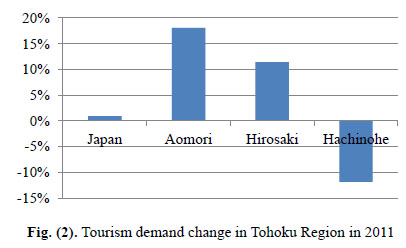
Tourism demand change in Tohoku Region in 2011
(Fig. (3)) shows the result for Kyushu Region. The extension of Kyushu Shinkansen was completed in March 2011. We divided cities in Kyushu Region into two categories: the ones that has not been connected by Shinkansen (left part) and ones that has been connected by Shinkansen (right part).
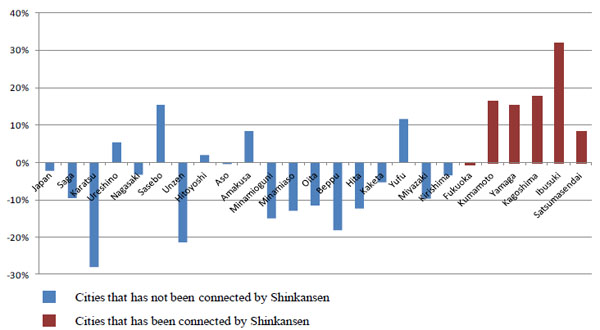
Tourism demand change in Kyushu Region in 2012.
In the year 2011, tourism industry in Japan was significantly impacted by the Great East Japan Earthquake, and tourism arrivals in most areas experienced a sharp decrease. However, in cities that were connected by the extended Shinkansen network, tourism arrivals showed considerable increase despite of the earthquake impact.
3.2. Change of Modal Share
(Fig. (4)) shows the change of modal share between OD pair of Tokyo and Aomori. After the completion of Tohoku Shinkansen in December 2010, the share of railway increased slightly in the following year, and showed an obvious increase to around 80% in the year 2012.

Change of modal share between Tokyo and Aomori from 2008 to 2012.
(Fig. (5)) shows the change of modal share between OD pair of Aichi and Kumamoto (left), and Osaka and Kumamoto (right). For both OD pairs, the share of railway has increased after the extension of Kyushu Shinkansen. Especially for OD pair of Osaka and Kumamoto, the share increased from 20% to around 50%. As the extension of Shinkansen reduced the travel time from Osaka to Kumamoto to 3 hours 15 minutes, it significantly increased the competitiveness of Shinkansen in terms of door-to-door time.
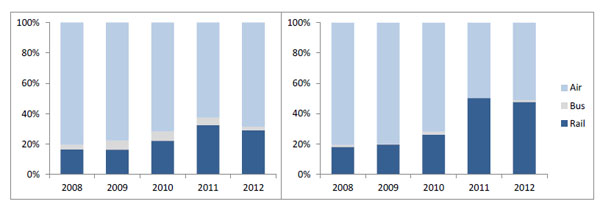
Change of modal share between Aichi and Kumamoto (left), Osaka and Kumamoto (right) from 2008 to 2012.
3.3. Change of Stay Duration
Change of stay duration has been analyzed by using data from accommodation survey. Fig. (6) shows the change of stay duration in Kyushu Region after the Shinkansen network extension. One can see that, except Saga prefecture, stay duration increased in two successive years (2011 and 2012) after the operation of Shinkansen. As the survey only includes information of overnight tourist’s stay duration, the result might be different if one day travel is included.
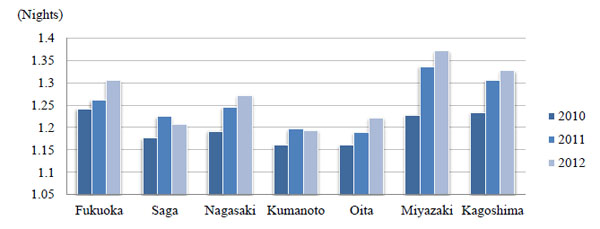
Change of stay duration in Kyushu Region from 2010 to 2012.
4. POLICY
In order to promote tourism development by utilizing Shinkansen, different policies have been adopted in Tohoku and Kyushu region. This paper reviews these policies through case studies of Hirosaki and Ibusuki city.
4.1. Introduction of Hirosaki and Ibusuki City
Hirosaki and Ibusuki cities share something in common when we discuss about the impact of Shinkansen on tourism development. Both cities are located around 40 km from Shinkansen station. In addition, expressway construction was not carried out at the same time with Shinkansen, thus we can examine the impact of Shinkansen separately.
Hirosaki city belongs to Aomori Prefecture. The city has an estimated population of 178,098 and the total area of 524.1 km². The city attracts many tourists because of its historic heritage, especially during its Sakura Festival and traditional Neputa Festival. But tourism demand in winter season is low due to the heavy snow.
Ibusuki is a city located in Kagoshima Prefecture. The city has an estimated population of 42,751 and the total area of 149.01 km². It has rich tourism resource such as Lake Ikeda, Uomidake nature park, Island Chiringashima, Kaimondake volcano, hot spring, and black-sand spas known as sunamushi onsen.
4.2. Policy Effort
In both Hirosaki and Ibusuki cities, a council was set up 5 years before the opening of HSR to discuss about strategy of tourism development. Therefore, it is possible to make tourism promotion and improve tourism infrastructure beforehand. But in Hirosaki city, such action had not been carried out until 2008, because of the delayed cooperation of related stakeholders. Such delay shorten the prepare time before the opening of Shinkansen.
The policy efforts made by the city include three aspects, which are environment improvement, attractiveness increase, and tourism promotion. Since it is difficult to have obvious effect through the former two aspects in a short time period, Hirosaki city focused on building destination brand through different events in the city.
On the other hand, Ibusuki city started the discussion five years before the opening of Shinkansen. And various efforts have been made to promote tourism development before and after the Shinkansen network extension.
The effort made by JR company includes accessibility improvement from Shinkansen station to tourism attractions, simultaneously operation of Shinkansen and access transport mode to tourism attractions, and introduction of special designed scenic trains.
The city and tourism industry has made efforts from several aspects:
- Increase attractiveness of hot spring As hot spring is important tourism resource in Ibusuki, the city made great effort to attract tourists to use hot spring. For example, they tried to attract female tourism by promotion of health tourism, and carried out different programs for tourists to have various experience by using hot spring resource.
- Improve environment of tourism attractions infrastructure has been improved in tourism attractions to enhance tourist experience. These efforts include establishing tourist information center and direction board; introduction of rent bicycle at major tourism attractions; reconstruction of several tourism attractions.
- Promote local food and souvenir the city also made efforts to promote local food through providing information about local cuisine on homepage of Ibusuki city; developing different cuisine by using local food; and distributing map of local restaurants.
- Human resources development to develop tourism personnel, the city has organized tourism guide group; distributed foreign language conversation books to citizens; distributed tourism guide books to students in elementary and junior high schools.
- Advertisement to attract more visitors advertisement efforts have been made to attract more visitors, including producing tourism promotion DVD in foreign languages; setting advertisement board around Shinkansen stations; and selecting Ibusuki tourism ambassador.
To develop tourism personnel, the city has organized tourism guide group; distributed foreign language conversation books to citizens; distributed tourism guide books to students in elementary and junior high schools.
4.3. Impact Analysis
In order to clarify the impact of HSR and policy effort on tourism demand, Ordinary Least Square (OLS) regression analysis is conducted here. The existing study has confirmed that tourism demand is influenced by various factors, including GDP, population, attractions (e.g., number of tourism spots), price, accessibility, and some policy variables. Following the earlier literature, we use the following equation to model tourism demand for city i in year t:
 |
(1) |
The dependent variable is the natural logarithm of the tourism demand to city i in year t. In this study, we choose 28 cities in Kyushu and Aomori Prefecture and analyze their tourism demand in the year after operation of Shinkansen. The explanatory variable, Demandi(t-1), is tourism demand to city i in year t-1, which represent the lagged effect of tourism demand. GDPit and Populationit are the GDP per capita and population level of city i. Number_Attit represents number of tourism attractions in city i. Priceit is the travel price. In the previous study, the influence of HSR has been represented by dummy variable of whether or not a city has Shinkansen station. In order to get a better understanding of the impact, this study uses a different variable, Distanceit, to represent distance from HSR station to main tourism attraction in city i. To reflect the influence of accessibility, Frequencyit is used to measure the frequency of railway from HSR station to city i. As being introduced in the previous section, various policy efforts have been made to promote tourism development before and after the Shinkansen network extension. Since it is difficult to represent some policies by variable, we only include the influence of scenic trains in this model. It is represented by a dummy variable STit, with 1 representing simultaneously operation of Shinkansen and scenic trains and 0 otherwise.
Due to the inclusion of the lagged dependent variable Demandi(t-1), a problem of endogeneity arises and regular OLS estimations will provide biased results. Both the within groups and random effects estimators are biased and inconsistent, unless the number of time periods is large. One solution to this problem is to first difference the model and use lags of the dependent variable as instruments for the lagged dependent variable. The solution given in this study is to use the GMM procedure of Arellano and Bond [12]. This estimator makes use of the fact that values of the dependent variable lagged two periods or more are valid instruments for the lagged dependent variable. This will generate consistent and efficient estimates of the parameters of interest. The dynamic model to be estimated will therefore be:
 |
(2) |
where
 , and analogously for the other variables. As data for GDP, population level, number of tourism attractions, and travel price is not available for every city, it is assumed that the value of these variables do not change during the target years. Therefore, the equation becomes:
, and analogously for the other variables. As data for GDP, population level, number of tourism attractions, and travel price is not available for every city, it is assumed that the value of these variables do not change during the target years. Therefore, the equation becomes:
 |
(3) |
It is expected that the influence of HSR will change over time. Therefore, in this study, we analyze tourism demand in two years (i.e., one year and two years after the operation of Shinkansen). Model estimation results are shown in Table 2. In the first year, the parameter for Demandi(t-1), Distanceit, and STit show significant influence at either 95% or 90% level. The positive parameter for Demandi(t-1) indicates strong lagged effect, which means tourism demand is influenced by previous year to a great degree. In this study, the impact of HSR is represented by variable Distanceit, which means distance from HSR station to main tourism attraction in city i. The model estimation result confirms the significant negative influence of this variable. It suggests that the shorter distant from HSR station will result in an increase of tourism demand to a certain destination. We have mentioned about the efforts that have been made to promote tourism development before and after the Shinkansen network extension, one of which is simultaneously operation of Shinkansen and scenic trains. Here, STit is a variable to measure the influence of such factor. The result shows that the simultaneously operation of Shinkansen and scenic trains will significantly increase the tourism demand. In terms of the second year, the lagged variable still shows significant influence. However, the influence of Distanceit, and STit become insignificant, which prove the impact of HSR and operation of scenic trains will decay over time. Although it has great influence on tourism demand in the first year, such influence no longer plays an important role in the second year.
Model estimation result.
| Explanatory variables | First year | Second year | ||
|---|---|---|---|---|
| Demandi(t-1) | 0.79 | * | 0.81 | * |
| Distance it | -0.62 | * | -0.27 | |
| Frequency it | 0.23 | 0.36 | ||
| ST it | 0.29 | * | 0.16 | |
CONCLUSION
In Japan, the High Speed Rail network is under extension recently. The Tohoku Shinkansen has been extended to Aomori in the year 2010 and the Kyushu Shinkansen has been extended to connect Fukuoka in the north with Kagoshima in the south and started operation in 2011. In order to clarify the impact of Shinkansen network extension on tourism development in Japan, this study investigates the change of tourism demand and tourist behavior in Tohoku and Kyushu Region by using statistical data collected by MLIT and JTA.
The results suggest that tourism arrivals increased significantly in cities that were connected by the extended Shinkansen network. Especially in Kyushu Region, the extension of Shinkansen network contributed to an obvious increase in tourism demand. We compared two groups of cities in Kyushu Region: the ones that has not been connected by Shinkansen and ones that has been connected by Shinkansen. The result shows the latter group had considerable increase in tourism arrivals, despite of the impact of Great East Japan earthquake that happened in 2011.
In addition, modal share of railway showed obvious increase as well. Concretely speaking, after the completion of Tohoku Shinkansen in December 2010, the share of railway between OD pair of Tokyo and Aomori showed an obvious increase to around 80% by the year 2012. In terms of Kyushu Region, we analyze the change of modal share between OD pair of Aichi -- Kumamoto, and Osaka -- Kumamoto. For both OD pairs, the share of railway has increased after the extension of Kyushu Shinkansen. Especially for OD pair of Osaka -- Kumamoto, the share increased from 20% to around 50% within one year.
This paper also reviews the policies that have been adopted to promote tourism development by utilizing Shinkansen through a case study of Ibusuki city. The effort made by JR company includes accessibility improvement from Shinkansen station to tourism attractions, simultaneously operation of Shinkansen and access transport mode to tourism attractions, and introduction of special designed scenic trains. The city and tourism industry has made efforts from several aspects, including increase attractiveness of hot spring, improve environment of tourism attractions, promote local food and souvenir, human resources development, and advertisement to attract more visitors. We suggest that the positive effects of the HSR might not be automatic but are results of the combination of various policy efforts, and cooperation of different stakeholders.
In order to clarify the impact of HSR and policy effort on tourism demand, Ordinary Least Square (OLS) regression analysis is conducted in this study. In the analysis, the influence of HSR is represented by a variable that measures distance from HSR station to main tourism attraction in a certain city. The frequency of railway from HSR station is used to reflect the influence of accessibility. Moreover, a dummy variable is used to represent simultaneously operation of Shinkansen and scenic trains. The model estimation result suggests that the shorter distant from HSR station will result in an increase of tourism demand to a certain destination. From such results, it can be concluded that the opening of Shinkansen will have great influence on tourism demand in area that is close to Shinkansen station. While for destination which is relatively far from station, accessibility improvement will play an important role. It can be proved by the significant influence of simultaneous operation of Shinkansen and scenic trains. However, such influence will decay over time. In order to keep the positive impact of Shinkansen, it is necessary to make effort from other aspects such as destination attractiveness improvement.
In the case of Hokuriku Shinkansen opened in March 2015, a scenic train was scheduled to operate to connect Kanazawa and Noto Peninsula. However, it has not opened simultaneously with Shinkansen. It is expected, therefore, the impact of Shinkansen on tourism demand will be weaken. The improvement of accessibility from Shinkansen to tourism destination is a strategy that deserves attention in the future tourism development by utilizing Shinkansen.
Some research issues remain as future tasks. First, the number of case studies in this study is limited and it is therefore necessary in future to collect more data in order to derive more general conclusions. Second, it is necessary to include more policy variables into the analysis. In this study, we only analyze the influence of scenic trains. In the next step, we will conduct a questionnaire survey to collect information about tourism stakeholder’s awareness of policy factors, and include such data into the impact analysis.
CONFLICT OF INTEREST
The authors confirm that this article content has no conflict of interest.
ACKNOWLEDGEMENTS
Declared none.


